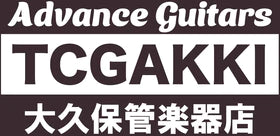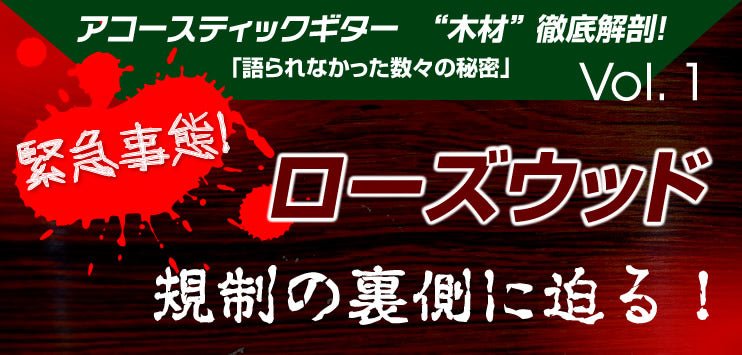- Part 1: The Many Unspoken Secrets
- Part 2: The New Hakaranda
- Part 3: Rare Rosewoods behind the New Hakaranda
- Part 4: Post Rosewood
2017In 2006, it was decided that international trade in rosewood would be restricted by the Washington Convention.
It is rumored that rosewood may soon no longer be used for guitars.
Rosewood is widely used in acoustic guitars for side backs, fingerboards, and bridges.
It is an essential part of acoustic guitars.
Did you know that rosewood, which has recently been regulated in general, actually comes in a variety of types?
There are also varieties of rosewood that are already regulated, such as theMartinis also a vintage to modern variety,
A wide variety of rosewoods have been used.
This time, we will focus on such popular rosewood,
the history of acoustic guitars.Martinguitars that have built the history of acoustic guitars!
[About Rosewood]
First of all, what is rosewood? I think it is known that it is a wood used roughly for guitars, Actually, rosewood(Rosewood)is a member of the Fabaceae family(Delbergia)(Delbergia) of the Fabaceae family. In Japan, it is called sandalwood(rosewood)It is also called shitan in Japan, and is known as a famous wood used not only for musical instruments but also for furniture, craftwork, and car interiors, The name "rosewood" comes from the rose-like aroma of the wood's cut edges.

- Rosewood has long been used for acoustic guitars because of its excellent stability, durability, and acoustic properties after seasoning. It has a dark reddish-brown color with many subdued grain patterns, and its unique burnished lines are exotic and beautiful, and the wood changes its appearance in various ways, giving it an unmistakable look and feel.
-
It is also known in Japan by the Spanish name”Hakaranda”but it is a completely different plant from jacaranda, which is in the genus Kirimodoki in the family Nodendaceae. Production of both electric and acoustic guitars became popular, and many Hakarandas were used1960In the 1950s, it was listed as an endangered species by the Washington Convention. Restrictions were placed on logging and international trade.
Even today, it is still valued as a top-quality wood, and both vintage guitars made with Hakaranda and guitars made from wood stocked from that time are sold at high prices. The high frequency range that can be easily pulled out, the low frequency range with tension and a sense of attack, the unquestionable overtones, and the sense of volume are the only ones that can be found. The unavailability of Brazilian rosewood has led to the emergence of many rosewood substitutes.

- Martin D-28

-
Martin D-28This is the most famous model of Martin.D-28D-28.
Called as the world standardD-28is made of rosewood for the side back.
Martin as a dreadnought.1931This model was first produced in 1949.1969The rose wood was made of hakaranda from the start of production until 1949.
It is a representative of vintage guitars in general.5,60of the 1950sD-28The D-28 has a unique, powerful, and far-reaching sound with the sparkle of Hakaranda.
- This is the1967made in 1949.D-28。

-
2Luxurious Hakaranda wood used in piece back. Beautiful piece with clear and flowing grains.
There are many individual differences in the grain of Hakaranda wood, but this age's Martin in particular has many different types of Hakaranda wood, both quarter-sawn and straight grain.
The Hakaranda's characteristic feeling of full bandwidth being pushed out, as well as the sense that the sound of the instrument is being played by the player...D-28The power of the D-28 is a perfect match for the Hakaranda's unique sense of full bandwidth push.
- Martin D-35

- D-28D-283As a piece back model1965It was born in 1949.D-35D-35 was born in 1949. The story behind the birth of the D-35 is that it was created due to the depletion of Hakaranda in the market at that time, Martin started to sell the D-35 by laminating a small number of materials.D-35The D-35 was the first of its kind. At first glance, it appears to be a way to increase the yield of lumber.3The piece-back construction may appear to be a way to increase the yield of wood, but its unique visual appearance, neck binding, and other features give it a one-of-a-kind presence and grade. Also,D-28The top bracing, which is thinner than that of the D-28D-35The thin top bracing produces a subtle and responsive sound that is unique to the D-35. 1965Production began in 1949, and Hakaranda was used in the1965The Hakaranda was used until 1949.D-35is very valuable.
- 1969Made in 1949. The last year of the HakarandaD-35。

-
Dark reddish brown color with deep grain with clear and easy to recognize yaki grain.3The piece back is alive with the goodness of piece back, and various expressions of Hakaranda can be seen.
With deep but crisp and dry Hakaranda sound,3The piece-back sound is balanced and attractive.
- As Brazilian rosewood became rare, Indian rosewood was widely used as a substitute for it.
-
Because it grows quickly and can be harvested in large quantities, it is generally used for guitars.”Rosewood”is the only wood that is generally used for guitars.
It is also called East Indian rosewood.
Compared to Hakaranda, it has wider canals and less reddish color.
Most of them have flat grain patterns and do not have exotic grain patterns like Hakaranda.
The acoustic characteristics are more flexible than those of Hakaranda, and it has an all-around sound with a wide range.
Compared to other rosewoods, it is often a little more subdued. The individual differences are wide, and the full bandwidth of the selected wood is supple and powerful, making it a must-hear.
It has been in stable supply, but perhaps due to the endless illegal practices of logging and importing/exporting other species as Indian rosewood,
2017Year, all types of rosewood(Cercidiphyllum japonicum/Dalbergia)The CITES regulation of Indian rosewood was enacted. Indian rosewood also became subject to regulation.
Although not completely regulated or banned like Hakaranda, there are concerns about future trends.
- Martin 000-28

-
1929Martin's first14It was produced as the first fret-jointed guitarOM-28。
The originalOMproduction was discontinued.1933The first one appeared in 1949.000-28。
OMsize body with0、00This model has excellent response, a delicate and beautiful sound, and easy fingering thanks to its small body and short scale, making it a popular model among fingerpickers.
The Hakaranda wood used from the early days was discontinued, and Indian rosewood began to be used.1970Even after 1949, Both the dreadnought and the dreadnought have been favored by many players. 
- Indian rosewood with smooth and flowing grain.
- The Indian rosewood used by Martin today has many individual differences in grain patterns, with a variety of symptoms. Indian rosewood is soft, supple, and well-balanced, and its delicacy is a selling point of the company.000-28The combination is a good match for the
- Martin D-45

- D-45is the1933The first one was ordered by country singer Gene Autry in 1949,1942By the year91The only existing The number of existing pieces is70It is said that there are only a few of them left in existence, making it an extremely rare gem among gems. The materials and quality control were more strictly checked than any other Martin models, and therefore, only a few were produced and only skilled craftsmen were allowed to make them. The Crosby Stills Nash & Young and Eric Clapton are known to have used this model.D-45and Eric Clapton, and later Mike Longworth and others.D-45In response to the many requests for the D-451968The D-45 is Martin's flagship model that continues to influence many makers and luthiers.

- The straight and clear grain of the wood is a feature of this model.1979Made in 1949D-45。
- With spruce45The Indian rosewood selected for the No. 2 wood gives off an overwhelming sense of power and overtones. The wide range of choices ranges from inexpensive, widely produced beginner models by various manufacturers to grades that are worthy of the king of Martin's finest, Indian rosewood.
- Martin D-41

- D-35andD-45which is an intermediate grade betweenD-41is an intermediate grade of1969was released in 1949. The very early Hakaranda-bodiedD-41is31Only two of them existed,1968~69year reproductionD-45Hakaranda body of229The number of pieces is very small compared to the book.D-45The mother-of-pearl inlay work is similar to that of the D-45.

- This model is made of Indian rosewood.1975Made in 1949D-41。
-
The evenly flowing wooden grain isD-28The wood grain is uniformly flowing and has a high-grade feel that differs from D-28.
The quintessence is40The sound is well-balanced with a sense of power.
70The number of Indian Rose pieces from the 1950s is decreasing, so they are becoming rarer and rarer.
postscript
How was it? This time from Brazilian rosewood, the ancestor of the finest rosewood, and after its regulation,6,70We have introduced Indian rosewood, which has been the most popular rosewood from the 1950s to the present day, in conjunction with Martin!
The future of rosewood has been under scrutiny due to the Washington Convention, which has led to the banning of the species and the need to apply for a permit.
The musical instrument industry may be facing a major turning point.
In the next issue, we would like to introduce other rare rosewoods that have been selected to fill the lost hole of Hakaranda! Check it out!

